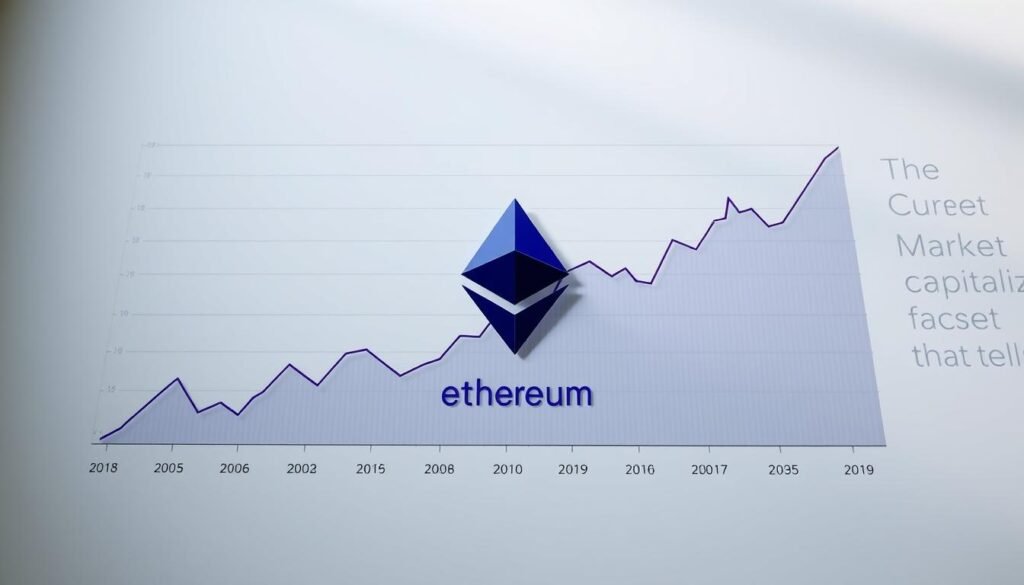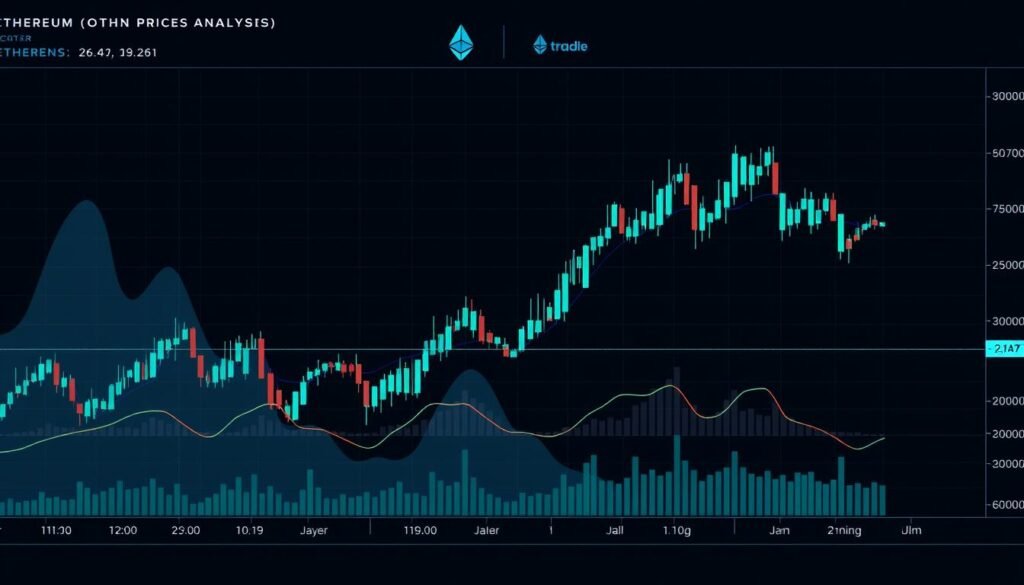The cryptocurrency market is buzzing as Ethereum’s spot trading volume hits $25.7 billion, overtaking Bitcoin for the first time. This milestone isn’t just a number—it reflects growing trust in Ethereum’s role beyond speculative trading. Investors are betting big on its smart contract capabilities and real-world applications.
Ethereum’s current price of $3,880 shows steady growth, climbing 0.46% today and 60.51% this month. Weekly gains of 3.52% and yearly growth of 19.45% highlight its resilience. Over $7.79 billion flowed into Ethereum-based products this year, with $1.59 billion added last week alone. These numbers suggest institutions see long-term value here.
What’s driving this momentum? The market is shifting toward assets with practical utility. While Bitcoin remains a store of value, Ethereum’s ecosystem supports decentralized apps and financial tools. Retail traders and big investors alike are recognizing its potential to reshape digital economies.
Key Takeaways
- Ethereum’s $25.7B trading volume signals a major shift in crypto market leadership
- Price stability across daily, weekly, and monthly charts shows strong investor confidence
- $7.79B in product inflows this year highlights institutional adoption
- Smart contract functionality positions Ethereum as a backbone for Web3 innovation
- Current price trends suggest sustained growth despite market volatility
Understanding the Shift in Cryptocurrency Trends
Recent data reveals a seismic change in digital asset preferences. The crypto markets now prioritize blockchain networks offering tangible utility over passive investments. This evolution becomes clear when analyzing trading patterns and investor behavior.
Spot Volume Breakdown
Ethereum’s $33.42 billion daily trading volume stands out for its organic growth. Unlike artificial pumps, this activity stems from real demand across decentralized apps and financial tools. The 0.0731 volume-to-market cap ratio confirms healthy liquidity—traders actively engage without overwhelming the network’s valuation.
Comparing ETH and BTC Dynamics
Bitcoin maintains its gold-like status, but Ethereum attracts a different crowd. Over $27 billion in open interest—the highest in years—shows traders leveraging ETH’s DeFi and NFT ecosystems. Institutions now allocate 20% more to Ethereum products than last quarter, signaling strategic confidence.
Three factors explain this shift:
- Smart contracts enable automated financial services
- NFT marketplaces drive cultural adoption
- Layer-2 solutions improve transaction efficiency
These developments create a feedback loop—more use cases attract users, which boosts market stability. As crypto evolves from speculation to application, Ethereum’s infrastructure positions it as a cornerstone of Web3 innovation.
Market Analysis: Ethereum’s Rising Market Capitalization
What does a $468 billion valuation tell us about Ethereum’s position in crypto? This staggering market capitalization cements its role as the backbone of decentralized innovation. Unlike projects with hidden token reserves, Ethereum’s full supply circulates today—a rare show of transparency.
Trading Volume Insights
The network’s $33.42 billion daily trading volume isn’t just impressive—it’s transformative. This liquidity attracts everyone from Wall Street firms to first-time buyers. High volume creates price stability, making large transactions smoother without drastic market swings.
Circulating Supply and Market Cap Explained
All 120.71 million existing tokens actively trade, with no future minting planned. This fixed supply model prevents inflation risks seen in other cryptocurrencies. When combined with its market cap, these metrics reveal a mature ecosystem built for lasting growth.
Three factors make this supply structure unique:
- No unminted tokens creating sell pressure
- Predictable inflation rates for investors
- Alignment between network users and token holders
This balance helps explain why institutions now view Ethereum as a blue-chip crypto asset. Its market cap reflects real utility, not just speculative hype.
The Role of Ethereum in Decentralized Applications
Blockchain technology is rewriting the rules of digital interaction, and Ethereum sits at the heart of this transformation. As the leading platform for decentralized applications, it powers tools that operate without corporate oversight. From finance to art ownership, these applications reshape how value moves online.
Smart Contracts Innovation
Ethereum’s smart contracts act like digital robots that enforce agreements automatically. Developers program rules directly into the blockchain, cutting out middlemen in transactions. This tech now handles everything from loan approvals to royalty payments for musicians.
What makes these contracts revolutionary? They enable systems that run 24/7 without human intervention. Imagine insurance that pays claims instantly after flight delays or trading platforms that match buyers globally. These aren’t theories—they’re live applications used daily.
Integration of NFTs and DeFi
The fusion of NFTs and decentralized finance creates unexpected possibilities. Digital art now doubles as loan collateral, while virtual land generates rental income. Ethereum’s network supports these hybrid use cases through its flexible architecture.
This synergy attracts both creators and investors. Artists monetize work through NFTs, then grow earnings via DeFi lending. Collectors use rare tokens to access exclusive financial products. It’s a self-reinforcing cycle powered by Ethereum’s infrastructure.
Technological Advancements in the Ethereum Network
The Ethereum network has undergone groundbreaking upgrades that redefine blockchain efficiency. At the core of this evolution lies Ethereum 2.0 – a complete overhaul improving speed, sustainability, and security. These changes address longstanding challenges while opening new possibilities for decentralized innovation.
Energy Efficiency Through Consensus Changes
Switching to proof-of-stake revolutionized how the blockchain operates. Instead of energy-intensive mining, validators now secure the network by staking tokens. This shift slashed energy use by 99% – equivalent to powering a lightbulb instead of a small city.
Users participate directly in network security while earning rewards. Over $30 billion worth of ETH is currently staked, creating strong economic incentives against malicious attacks. This system makes compromising the blockchain financially impractical for bad actors.
Three key benefits emerged from these upgrades:
- Faster transaction finality (12 seconds vs. 6 minutes previously)
- Lower entry barriers for network participation
- Enhanced environmental credentials attracting ESG-focused investors
Layer-2 solutions like Arbitrum amplify these improvements. By handling transactions off the main network, they reduce fees by 90% while maintaining security. This combination positions Ethereum as the go-to blockchain for scalable Web3 applications.
ETH Price Trends and Future Predictions
Ethereum’s market performance continues to capture investor attention as it charts a steady upward trajectory. The digital asset currently trades at $3,880.2, showing consistent gains across multiple timeframes. This stability contrasts with typical crypto volatility, signaling maturing market behavior.
Recent Price Movements and Weekly Trends
Over the last hours, Ethereum price action has maintained its momentum with a 0.46% daily increase. Weekly gains of 3.52% and a striking 60.51% monthly jump highlight accelerating institutional adoption. These numbers suggest investors see long-term value beyond short-term speculation.
Forecasts and Analyst Projections
Analysts paint an optimistic picture for coming years. Current projections place Ethereum’s average price at $4,054 by 2025, with some forecasts reaching $6,000. While predictions vary, the consensus acknowledges Ethereum’s unique position in powering Web3 infrastructure.
Technical charts reinforce this positive outlook. Multiple indicators across daily, weekly, and monthly timeframes show strong buy signals. These patterns suggest the current price trends have solid support from market fundamentals rather than temporary hype.
Impact of Trading Volume on Crypto Market Dynamics
Market analysts are closely watching how trading activity shapes crypto’s future. When digital assets see consistent volume growth, it signals deeper structural changes. These shifts affect everything from price stability to mainstream adoption.
Recent Inflows and Market Sentiment
This year’s $7.79 billion flowing into Ethereum products tells a clear story. Investors see real-world value in decentralized networks. Last week’s $1.59 billion surge – the second-largest weekly inflow ever – confirms this bullish trend.
Round-the-clock trading activity shows global participation. Markets stay active across all time zones, with consistent volume during Asian, European, and American hours. This 24/7 engagement builds trust in crypto’s liquidity.
Volume’s Role in Price Volatility
High trading volume acts like shock absorbers for prices. Ethereum’s $33.42 billion daily activity lets large trades happen smoothly. This reduces sudden price jumps that scare away cautious investors.
Institutions particularly value this stability. Fund managers need predictable markets to manage risk. As volume remains strong, manipulation becomes harder – creating safer conditions for everyone.
Today’s crypto landscape rewards networks with organic growth. Trading metrics now reflect utility, not just speculation. This evolution suggests lasting changes in how markets value blockchain technology.
Exploring Ethereum’s Network and Its Innovations
Ethereum’s architecture continues to evolve, solving critical challenges through layered solutions. The blockchain now operates like a digital highway system – main routes handle security while express lanes manage high-speed transactions. This multi-tiered approach keeps the network efficient as adoption grows.
Breaking Through Bottlenecks
Layer-2 solutions like Arbitrum and Optimism act as turbochargers for the Ethereum blockchain. These enhancements process transactions off the main chain, slashing fees by 90% while maintaining security. Developers can now build apps supporting thousands of users without congestion issues.
Three key improvements define this upgrade:
- Instant settlements for micropayments and NFT trades
- Cross-chain compatibility with other blockchain networks
- Energy-efficient validation methods complementing Ethereum’s proof-of-stake model
The network’s flexibility shines through token innovations. Programmable tokens now represent everything from concert tickets to carbon credits. Smart contracts automatically manage these assets, enabling complex financial tools anyone can access.
What makes the Ethereum blockchain unique? Continuous upgrades ensure compatibility with older applications while introducing new capabilities. This balance between innovation and stability keeps developers committed to building the decentralized web’s foundation.
Deep Dive into ETH: Key Insights an
The numbers tell a compelling story – Ethereum’s ecosystem now drives fundamental shifts in digital finance. Its $25.7 billion trading milestone marks more than market leadership. It showcases how blockchain utilities are reshaping global economic systems.
Three strengths position Ethereum for sustained growth. Smart contracts automate complex agreements at scale. DeFi platforms democratize financial services worldwide. NFTs bridge physical and digital ownership through provable scarcity.
Institutional adoption patterns reveal strategic confidence. Major firms now build infrastructure around Ethereum’s network rather than just trading its token. This shift from speculation to implementation signals long-term commitment.
Looking ahead, Ethereum faces exciting challenges. Scaling solutions must keep pace with user growth while maintaining security. Regulatory clarity could accelerate enterprise adoption. As Web3 matures, Ethereum’s role as its foundation appears increasingly secure.
The network’s evolution reflects crypto’s broader journey – from experimental technology to essential infrastructure. For investors and developers alike, Ethereum offers a front-row seat to tomorrow’s digital economy.
FAQ
Why did Ethereum’s spot trading volume surpass Bitcoin’s recently?
Increased demand for decentralized applications, NFTs, and DeFi platforms built on Ethereum drove higher trading activity. Investors also anticipate growth from upgrades like Ethereum 2.0 and potential ETF approvals.
How does Ethereum’s market capitalization compare to Bitcoin?
While Bitcoin remains the largest cryptocurrency by market cap, Ethereum’s faster-growing ecosystem and innovations in smart contracts have narrowed the gap. Its market cap reflects growing trust in its long-term utility.
What role do smart contracts play in Ethereum’s value?
Smart contracts automate agreements without intermediaries, powering DeFi platforms, NFTs, and enterprise solutions. This versatility makes Ethereum a backbone for blockchain innovation, boosting its adoption and price.
How has Ethereum 2.0 impacted its network performance?
The shift to proof-of-stake reduced energy use by 99% and improved scalability. Staking rewards also incentivize users to secure the network, creating a more sustainable and efficient ecosystem.
Can Ethereum’s price volatility affect decentralized applications?
While price swings influence short-term trading, most decentralized apps focus on utility over speculation. Stablecoins and layer-2 solutions help mitigate volatility risks for everyday users and developers.
What factors could drive Ethereum’s price higher in 2024?
Key catalysts include institutional adoption through ETFs, expanded use cases in gaming or enterprise, and successful implementation of scalability upgrades like sharding. Market sentiment around crypto regulation also plays a role.
How do layer-2 solutions improve Ethereum’s scalability?
Layer-2 networks like Arbitrum and Optimism process transactions off-chain, reducing fees and congestion. This enhances user experience for DeFi and NFTs while maintaining Ethereum’s security.
Why is the circulating supply important for evaluating Ethereum?
Circulating supply affects market cap calculations and scarcity. Unlike Bitcoin, Ethereum’s supply isn’t capped; however, staking and token burns through EIP-1559 create deflationary pressure, influencing the long-term value.





